What Makes a Faster Hurdler?
When it comes to sprinting, we often talk about stride length and stride frequency as the keys to speed. But hurdling is a different equation. In hurdling, the name of the game is stride frequency between hurdles.
Both a 15-second hurdler and a 13-second hurdler take the same number of strides to finish the race—50 strides in total.
So, what separates them? Speed between the hurdles, the efficiency of hurdle technique and clearance, and the ability to re-accelerate after clearing each hurdle.
To hurdle faster, you need to focus on five main areas:
- Accelerating to the first hurdle
- Efficient and consistent hurdle clearance
- High stride frequency between hurdles
- Quick re-acceleration after each hurdle
- An explosive final push from the last hurdle to the finish line
1. Start Fast, Start Smooth
A smooth, explosive start with rapid acceleration to the first hurdle is key to the fastest possible rhythm between hurdles.
Here’s how to set up your blocks for hurdlers: Lead leg in the back of the block, trail leg up front.

For anyone that is not an elite hurdler - an 8-step approach is typically best.
Some top-tier hurdlers use a 7 step approach for better momentum and fewer strides. But forcing 7 strides often leads to over-striding and a slower rhythm over the hurdles.
The first 4 strides, should be focused on explosive sprinting, with a gradual rise to an upright position for the final 4 strides before the hurdle.
Around the 5th stride, the hurdler should have a tall body posture to allow the center of mass to be at a maximally high launching level.
Proper sprinting technique is critical for generating the most force in the shortest time.
The goal isn’t just a fast start to the first hurdle - it’s generating velocity through it and maintaining a high stride frequency for the remaining hurdles.
Common hurdling errors to avoid in at the start of the race:
- Popping up too early - If you get upright to quickly, you are losing vertical velocity.
- Over-striding - If you over-stride or reach, you aren’t applying as much force as possible. This will sink your speed.
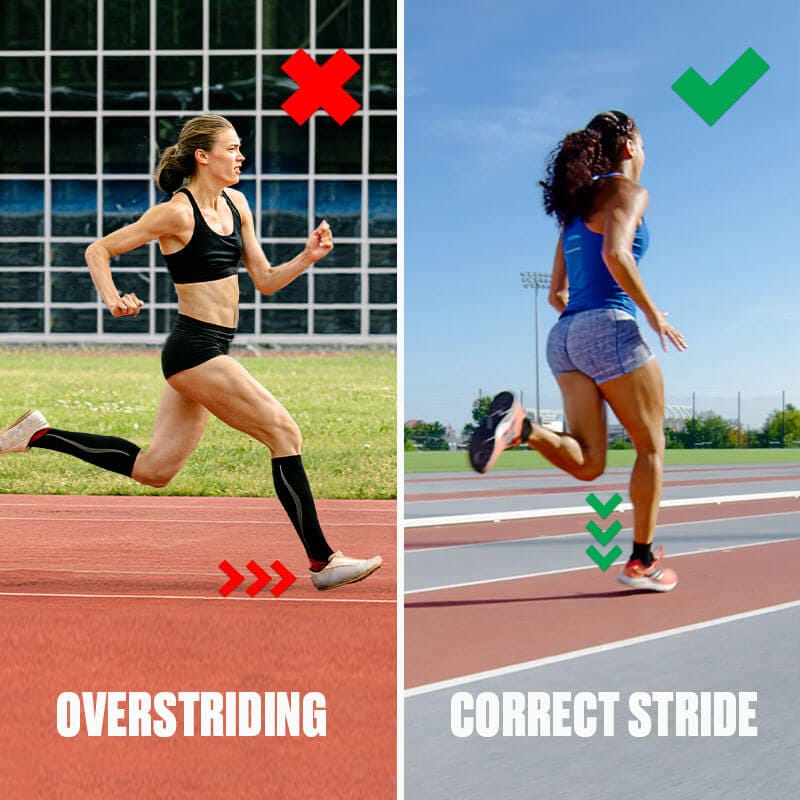
2. Efficient and Consistent Hurdle Technique
Lead Leg Technique
The lead leg plays a significant role in controlling hurdle clearance - the quicker the lead leg, the quicker the touchdown.
A common misconception is that hurdlers lead with the foot.
This often results in a straight leg, dropping the hips and slowing you down.
Instead, hurdlers should lead with the knee.
Steps to proper lead leg technique:
- Keep the lead leg bent, with the knee driving toward the hurdle.
- Attack the hurdle with high knee action, powered by the hip flexors.
- Unhinge the knee quickly over the hurdle, keeping the toe pointed up.
- Snap the lead leg down to land under the hips.
- Plant the lead leg firmly to prevent dropping your center of mass and losing horizontal velocity.
Mastering these steps will keep your clearance low, reduce your arc, and help maintain maximum horizontal speed.
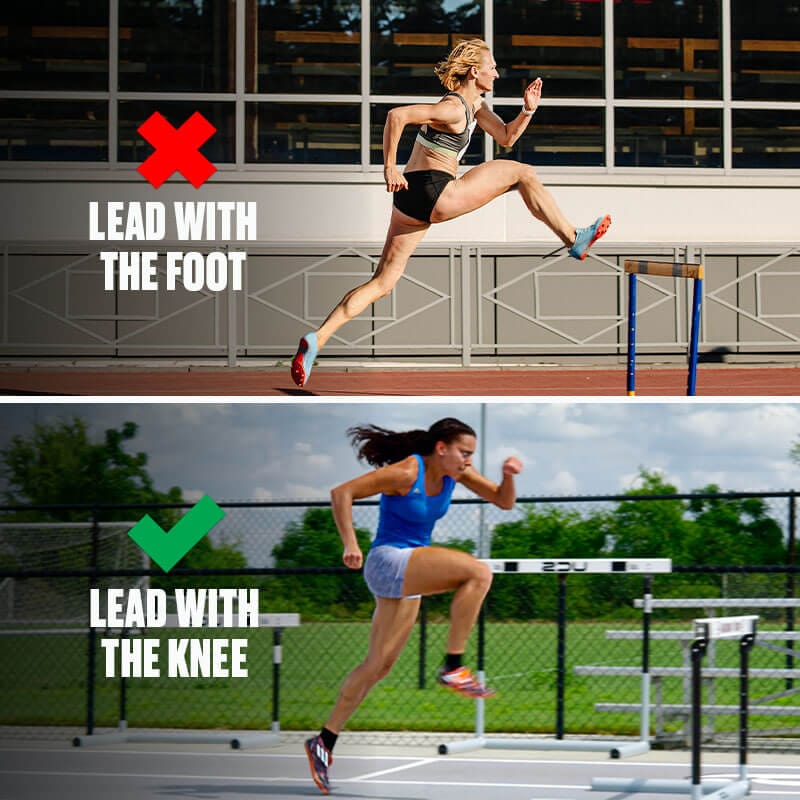
Trail Leg Technique
A lazy trail leg leads to Band-Aids. Get over the hurdles quicker and more efficiently, with all skin intact, by pulling it high and tight.
Steps to proper trail leg technique:
- As soon as the back leg pushes off, rotate the foot externally (right foot - 3 o'clock or left foot - 9 o'clock).
- Then, pull the heel to the glute and keep it there while raising the knee to the side at close to a 90-degree angle to the ground.
- From there, swing the leg forward without letting the ankle rise above the knee, keeping a slight upward angle as you clear the hurdle.
- Make sure the trail leg comes all the way forward, sprinting through the hurdle, before dropping into your first stride after the hurdle.
This moment should be as quick as possible while achieving proper form. The one who gets their trail leg down first will win the race.
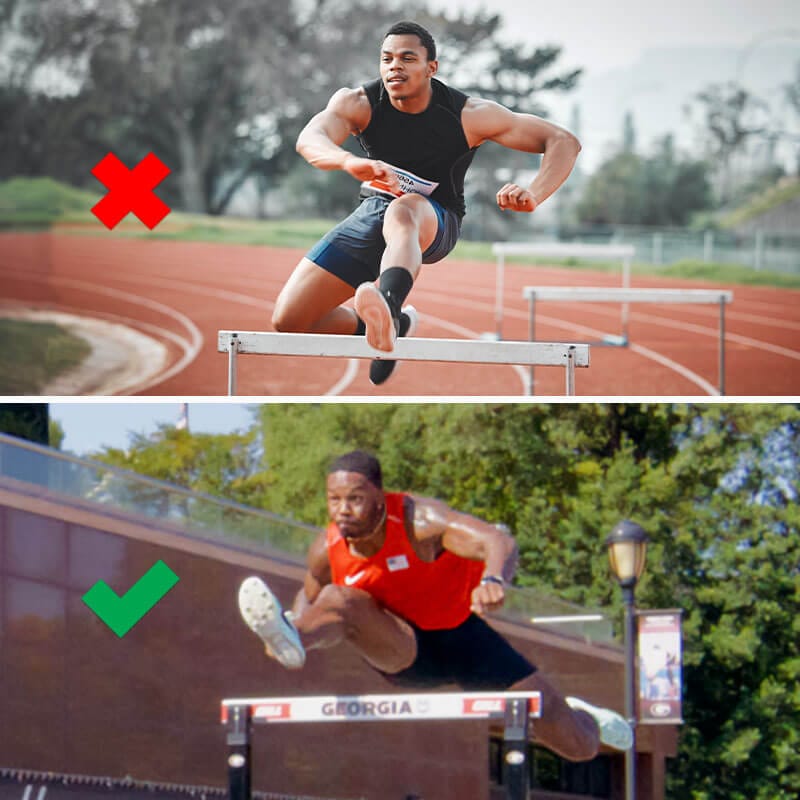
Hurdling Arm Technique
Between hurdles, an athlete's arms should pump like in a regular sprint, maintaining power and speed.
While clearing a hurdle, use your arms to stay balanced as your legs make larger, more exaggerated movements.
Steps to proper hurdling arm technique:
- The lead arm should stay in the direction of travel, not crossing the sternum.
- As the lead leg goes over the hurdle, the opposite arm extends in front, slightly bent, like "looking at your watch," keeping balance.
- As the trail leg comes through, extend the elbow and swing the arm back, with the hand meeting the trail knee (for women) or the trail elbow (for men). This helps transition smoothly back into sprinting.
Avoid straightening the arm, as it can disrupt balance, especially for beginners.
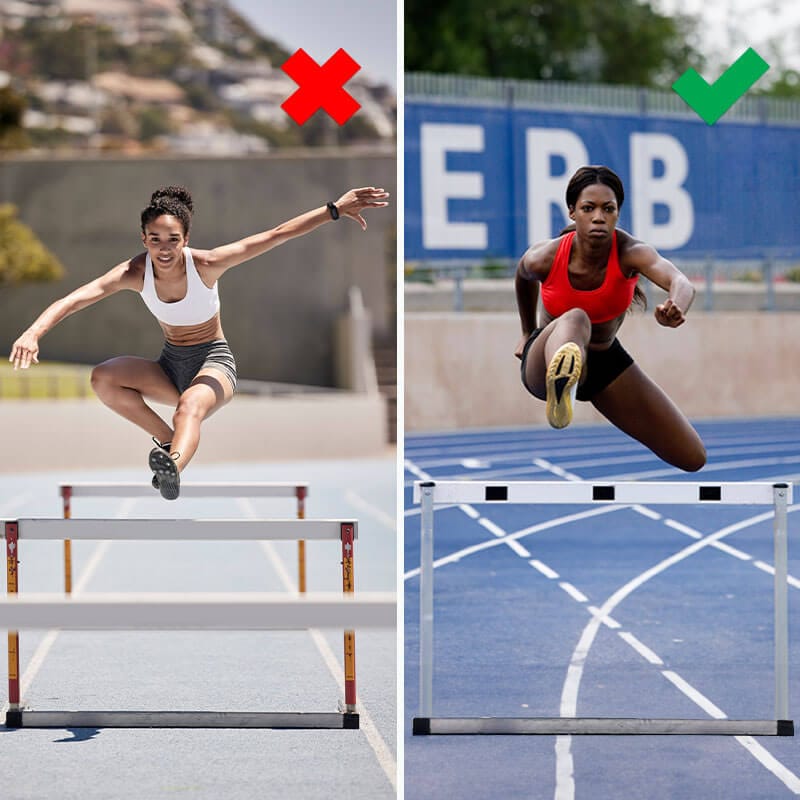
Consistent Hurdle Clearance is a Must
When clearing the hurdles, remember that the less time you spend in the air, the more time you are on the ground generating speed.
The takeoff distance from the hurdle determines clearance height and affects everything: the angle of travel, landing distance, and speed to the next hurdle.
Too far from the hurdle, and you'll sail (go too far).
Too close, and you vault (go too high).
Keep the curve as flat as possible over the hurdle to maintain speed.
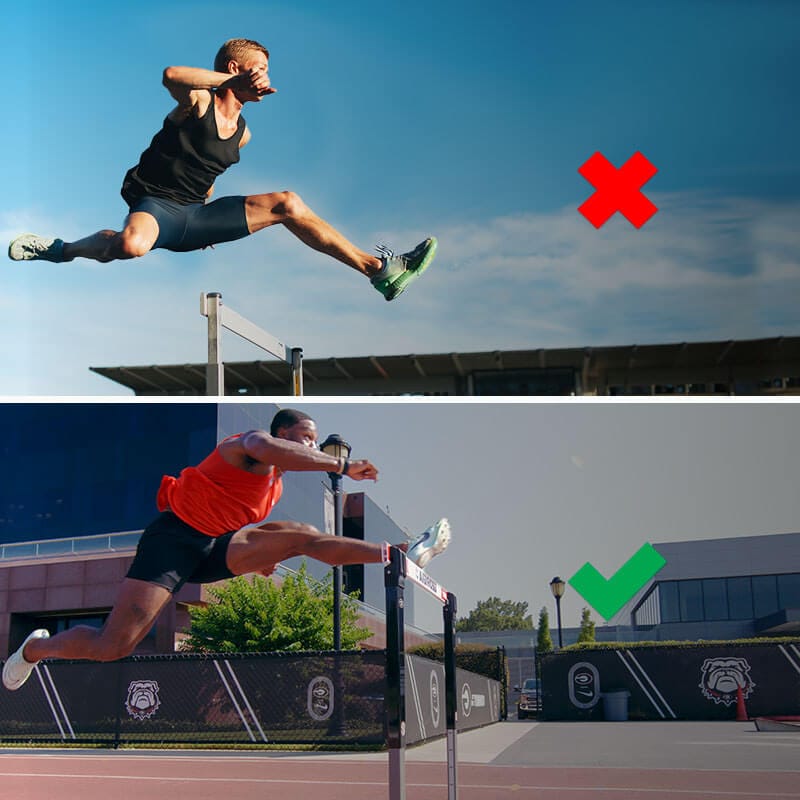
Hurdle clearance is all about consistency. The stride length between your takeoff and landing should stay the same throughout the race to maintain that all-important rhythm.
Without it, your stride shuffle between the hurdles will fall apart. Nail the consistency of your clearance stride, and you'll be on track to improve your overall hurdling.
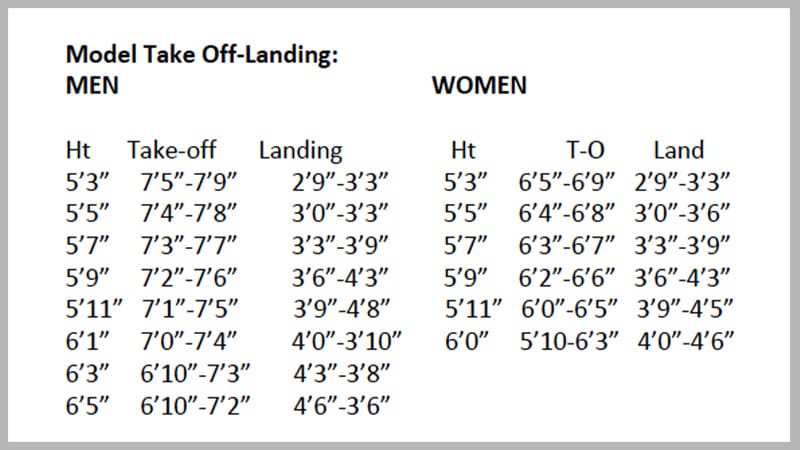
3. Great Hurdlers Are Aggressive Between Hurdles
Once you’re between the hurdles, the spacing is fixed. To run faster, you don’t want to stretch out your stride; instead, you need to “shuffle” faster.
This “shuffle” refers to maintaining a quick, consistent stride without increasing stride length. If you overextend your strides between the hurdles, you’ll “run out of room” and crash right into the hurdle.
And that’s a surefire way to slow you down. So, to stay fast, you’ve got to stay aggressive—keep those strides compact and powerful.
The trail leg, or “power leg,” plays a crucial role in generating speed. Its steps are longer than those of the lead leg throughout the race.
The trail leg performs two key “cut step” actions: one during take-off and another during re-acceleration after clearing the hurdle.
The take-off step should be shorter than the previous stride, with the foot planting directly under the hips to reduce braking force and maintain speed through the hurdle.
4. Re-Acceleration After Each Hurdle
This is where the second “cut step” comes in. It occurs after the hurdle, as the trail leg’s foot lands under the hips to minimize braking and ensure a powerful push-off, allowing for ideal re-acceleration between hurdles.
Mastering that hurdle shuffle is important, but don’t forget to develop your overall speed, strength, and power.
For hurdlers without natural speed, this is critical.
Your flat sprint stride is typically longer than your hurdling stride, and that’s a good thing—it lets you sprint between hurdles at a lesser percentage of your max stride length.
The result? It’s faster turnover, better rhythm, and a more consistent race pace.
5. The Most Important Element - Maintaining Horizontal Velocity
Even if you master everything, one thing can destroy your speed: losing horizontal velocity. The best hurdlers know how to maintain momentum throughout the race and finish strong - that’s where proper sprinting technique comes in.
TLDR - Hurdle Technique Tips to Boost Speed:
1. Get Tall Early
By your fifth stride, you should be transitioning into a tall, upright posture to launch yourself into the hurdle with minimal vertical movement. The less vertical you go, the faster you move forward.
2. Use the Power Leg and Cut Step
Your trail leg, or “power leg,” is essential for two key actions: cutting the takeoff step and re-accelerating after the hurdle. Keep your foot close under your hips during takeoff to minimize braking force and carry your speed through the hurdle.
3. Take Off at the Right Distance
Taking off too close to the hurdle means you’ll either crash into it or jump too high, both of which will kill your momentum. Find the right takeoff distance for your height to maintain a smooth, efficient parabolic curve over the hurdle.
4. Lead with the Knee
Leading with the knee helps keep your clearance low and fast. It reduces the height of your arc, letting you maintain more horizontal speed.
5. Minimize Landing Amortization
When you land, your lead leg should be straight and vertical. Don’t let your leg give in to the landing forces—keep it strong to prevent your center of mass from dropping and losing velocity.
6. Stay Tall Between Hurdles
Keeping a tall posture while sprinting between hurdles allows you to maximize horizontal velocity. This pre-tension in your muscles lets you take full advantage of the stretch-shortening cycle in each stride.
7. Dive Through the Hurdle
Don’t just jump over the hurdle—dive through it. This starts with a powerful plant of your takeoff foot, a quick lead leg, and a tight trail leg to keep your momentum moving forward.
8. Keep Your Sprinting Mechanics Tight
A few key details to remember:
- Keep hips and shoulders square
- Lead with your knee, not your foot
- Keep your trail leg tight and pull it through, not just over, the hurdle
- Use your arms efficiently—no crossing the body
- Sprint through the hurdle, don’t just clear it
By focusing on these fundamentals, you’ll be able to improve your stride efficiency, maintain speed between hurdles, and minimize any loss of momentum.
Remember—hurdling is all about rhythm, consistency, and aggression. Get those elements working together, and you or your athletes will be crossing the finish line at PR pace.
To learn more about maximizing your hurdling technique and training, check out Hurdling Smarter.


Great article coach loved it but one thing I couldn't seem to achive is sprinting between the hurdles I run a low 15 but I know I could do more I don't understand how to make that 9.14 meters feel so tight for me looking forward to hearing from you thank you
Thanks so much for the kind words—really glad the article resonated with you!
That feeling of being tight between the hurdles is super common, especially when you're just on the edge of breaking through to the next level. You're absolutely right to focus on sprinting between the hurdles, that’s where big time drops happen.
A few things to think about:
Lead With the Knee: Make sure you’re attacking the hurdle with your knee, not your foot. This keeps you in a sprinting posture and helps you maintain horizontal speed.
Trail Leg Recovery: Getting the trail leg down quickly is key. A fast, direct trail leg path lets you re-establish sprint mechanics faster and makes that 9.14m feel less cramped.
Sprint Rhythm: Between hurdles, think of it like sprinting on flat ground—strong arm action, front-side mechanics, and no hesitation.
At low 15s, you’re right in that range where small improvements in rhythm and posture can lead to big gains!